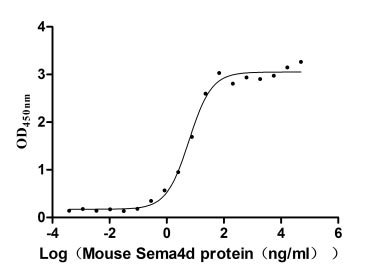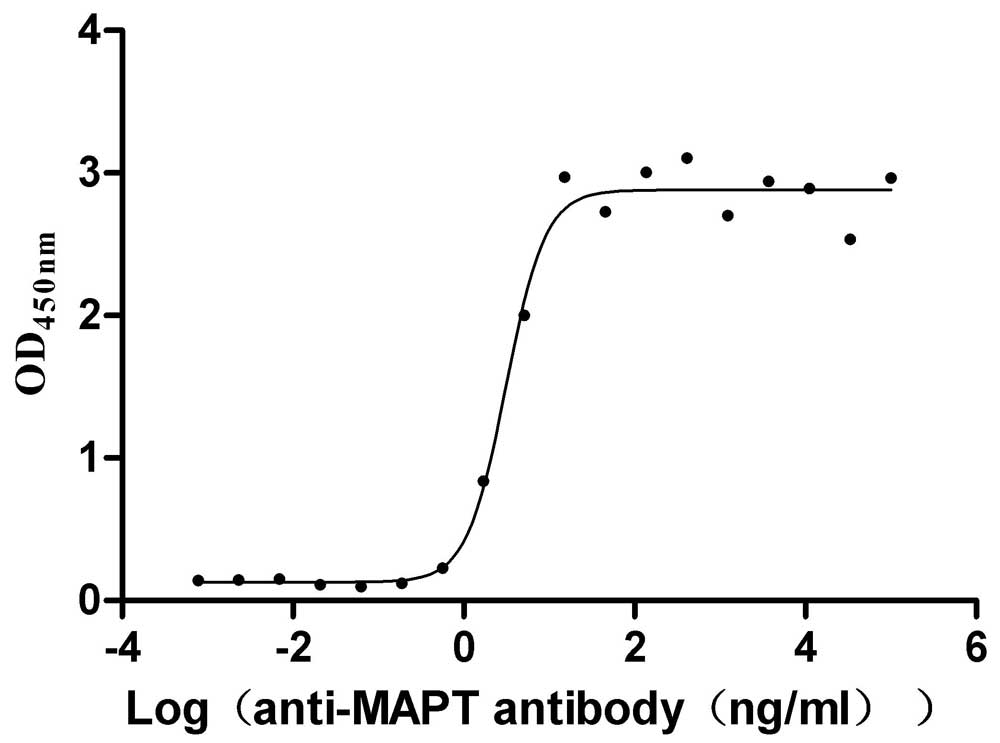Recombinant Human Large proline-rich protein BAG6 (BAG6), partial
In Stock-
货号:CSB-EP342402HU
-
规格:¥1836
-
图片:
-
其他:
产品详情
-
纯度:Greater than 85% as determined by SDS-PAGE.
-
基因名:BAG6
-
Uniprot No.:
-
别名:2410045D21Rik; AA408914; BAG 6; BAG family molecular chaperone regulator 6; BAG-6; BAG6; BAG6_HUMAN; BAT 3; BAT3; BCL2-associated athanogene 6; D17H6S52E; D6S52E; G3; HLA B associated transcript 3; HLA-B associated transcript 3; HLA-B associated transcript-3; HLA-B-associated transcript 3; large proline rich protein BAG6; Large proline rich protein BAT3; Large proline-rich protein BAG6; large proline-rich protein BAT3; Protein G3; Protein Scythe; Scythe; Scythe; homolog of Xenopus
-
种属:Homo sapiens (Human)
-
蛋白长度:Partial
-
来源:E.coli
-
分子量:41.7 kDa
-
表达区域:1-321aa
-
氨基酸序列MEPNDSTSTAVEEPDSLEVLVKTLDSQTRTFIVGAQMNVKEFKEHIAASVSIPSEKQRLIYQGRVLQDDKKLQEYNVGGKVIHLVERAPPQTHLPSGASSGTGSASATHGGGSPPGTRGPGASVHDRNANSYVMVGTFNLPSDGSAVDVHINMEQAPIQSEPRVRLVMAQHMIRDIQTLLSRMECRGGPQPQHSQPPPQPPAVTPEPVALSSQTSEPVESEAPPREPMEAEEVEERAPAQNPELTPGPAPAGPTPAPETNAPNHPSPAEYVEVLQELQRLESRLQPFLQRYYEVLGAAATTDYNNNHEGREEDQRLINLVG
Note: The complete sequence including tag sequence, target protein sequence and linker sequence could be provided upon request. -
蛋白标签:N-terminal 10xHis-tagged and C-terminal Myc-tagged
-
产品提供形式:Liquid or Lyophilized powder
Note: We will preferentially ship the format that we have in stock, however, if you have any special requirement for the format, please remark your requirement when placing the order, we will prepare according to your demand. -
缓冲液:Tris-based buffer,50% glycerol
-
储存条件:Store at -20°C/-80°C upon receipt, aliquoting is necessary for mutiple use. Avoid repeated freeze-thaw cycles.
-
保质期:The shelf life is related to many factors, storage state, buffer ingredients, storage temperature and the stability of the protein itself.
Generally, the shelf life of liquid form is 6 months at -20°C/-80°C. The shelf life of lyophilized form is 12 months at -20°C/-80°C. -
货期:3-7 business days
-
注意事项:Repeated freezing and thawing is not recommended. Store working aliquots at 4°C for up to one week.
-
Datasheet & COA:Please contact us to get it.
相关产品
靶点详情
-
功能:ATP-independent molecular chaperone preventing the aggregation of misfolded and hydrophobic patches-containing proteins. Functions as part of a cytosolic protein quality control complex, the BAG6/BAT3 complex, which maintains these client proteins in a soluble state and participates in their proper delivery to the endoplasmic reticulum or alternatively can promote their sorting to the proteasome where they undergo degradation. The BAG6/BAT3 complex is involved in the post-translational delivery of tail-anchored/type II transmembrane proteins to the endoplasmic reticulum membrane. Recruited to ribosomes, it interacts with the transmembrane region of newly synthesized tail-anchored proteins and together with SGTA and ASNA1 mediates their delivery to the endoplasmic reticulum. Client proteins that cannot be properly delivered to the endoplasmic reticulum are ubiquitinated by RNF126, an E3 ubiquitin-protein ligase associated with BAG6 and are sorted to the proteasome. SGTA which prevents the recruitment of RNF126 to BAG6 may negatively regulate the ubiquitination and the proteasomal degradation of client proteins. Similarly, the BAG6/BAT3 complex also functions as a sorting platform for proteins of the secretory pathway that are mislocalized to the cytosol either delivering them to the proteasome for degradation or to the endoplasmic reticulum. The BAG6/BAT3 complex also plays a role in the endoplasmic reticulum-associated degradation (ERAD), a quality control mechanism that eliminates unwanted proteins of the endoplasmic reticulum through their retrotranslocation to the cytosol and their targeting to the proteasome. It maintains these retrotranslocated proteins in an unfolded yet soluble state condition in the cytosol to ensure their proper delivery to the proteasome. BAG6 is also required for selective ubiquitin-mediated degradation of defective nascent chain polypeptides by the proteasome. In this context, it may participate in the production of antigenic peptides and play a role in antigen presentation in immune response. BAG6 is also involved in endoplasmic reticulum stress-induced pre-emptive quality control, a mechanism that selectively attenuates the translocation of newly synthesized proteins into the endoplasmic reticulum and reroutes them to the cytosol for proteasomal degradation. BAG6 may ensure the proper degradation of these proteins and thereby protects the endoplasmic reticulum from protein overload upon stress. By inhibiting the polyubiquitination and subsequent proteasomal degradation of HSPA2 it may also play a role in the assembly of the synaptonemal complex during spermatogenesis. Also positively regulates apoptosis by interacting with and stabilizing the proapoptotic factor AIFM1. By controlling the steady-state expression of the IGF1R receptor, indirectly regulates the insulin-like growth factor receptor signaling pathway.; Involved in DNA damage-induced apoptosis: following DNA damage, accumulates in the nucleus and forms a complex with p300/EP300, enhancing p300/EP300-mediated p53/TP53 acetylation leading to increase p53/TP53 transcriptional activity. When nuclear, may also act as a component of some chromatin regulator complex that regulates histone 3 'Lys-4' dimethylation (H3K4me2).; Released extracellularly via exosomes, it is a ligand of the natural killer/NK cells receptor NCR3 and stimulates NK cells cytotoxicity. It may thereby trigger NK cells cytotoxicity against neighboring tumor cells and immature myeloid dendritic cells (DC).; Mediates ricin-induced apoptosis.
-
基因功能参考文献:
- The observations suggest a mechanism whereby the BAG6 ubiquitin-linked domain provides a platform for discriminating substrates with shorter hydrophobicity stretches as a signal for defective proteins. PMID: 26663859
- BAG6 co-localizes with HSPA2 in huinan testicular germ cells and epididymal spermatozoa, moving from the equator to the anterior head during capacitation and stably interacting with HSPA2. In zona pellucida binding defect infertility, BAG6 is lacking. PMID: 26153132
- we found BAG6 to be dispensable in antigen processing PMID: 26598275
- VNTR in the coding region of the FAM46A gene, FAM46A rs11040 SNP and BAG6 rs3117582 SNP are associated with susceptibility to tuberculosis PMID: 24625963
- BAG6 rs3117582 SNP was associated with non small cell lung cancer in the Norwegian subjects and the combined Croatian-Norwegian subjects corroborating the earlier finding that BAG6 rs3117582 SNP was associated with lung cancer in Europeans. PMID: 25884493
- Data show that molecular chaperone BAG6_ubiquitin-like domain (UBL) and ubiquitin-like 4A UBL4A_UBL compete for the same binding site on N-terminal dimerisation domain of SGTA protein (SGTA_NT). PMID: 25415308
- This meta-analysis suggested that HLA-B-associated transcript 3 polymorphisms are risk factors for lung cancer. PMID: 25430685
- Both TRC35 and Ubl4A have distinct C-terminal binding sites on Bag6 defining a minimal Bag6 complex. PMID: 25535373
- Exogenous BAG6 perturbs the function of the BAG6 complex at a stage subsequent to substrate recognition and polyubiquitylation, most likely the BAG6-dependent delivery of OpD to the proteasome. PMID: 24806960
- Susceptibility to large-joint osteoarthritis (hip and knee) is associated with BAG6 rs3117582 SNP and the VNTR polymorphism in the second exon of the FAM46A gene on chromosome 6. PMID: 25231575
- Tim-3/Gal-9 interaction favors apoptosis of MBP-specific T lymphocytes in benign multiple sclerosis; this process is reduced in PPMS by the up-regulation of Bat3 PMID: 25091272
- show that endogenous dislocation clients are captured specifically in association with the cytosolic chaperone BAG6, or retrieved en masse via their glycan handle PMID: 24594942
- This meta-analysis suggested that BAT3 polymorphisms contributed the development of lung cancer. PMID: 24989925
- RNF126 is recruited to the N-terminal Ubl domain of Bag6 and preferentially ubiquitinates juxtahydrophobic lysine residues on Bag6-associated clients. PMID: 24981174
- Bag6, a protein in the TRC pathway that is also responsible for the degradation of mislocalized proteins, is not only involved in core particle assembly but also has a key role in efficient regulatory particle assembly. PMID: 23900548
- we show for the first time that BAG-6(686-936) comprises a subdomain of BAG-6, which is sufficient for receptor docking and inhibition of NKp30-dependent NK cell cytotoxicity as part of a tumor immune escape mechanism PMID: 24133212
- Data indicate that BCL2-associated athanogene 6 (BAG6) appears to be the central component for the process, as depletion of BAG6 leads to the loss of both UBL4A and GET4 proteins and resistance to cell killing by DNA-damaging agents. PMID: 23723067
- Data indicate that the Bag6-Ubl4A-Trc35 complex is localized to the endoplasmic reticulum (ER) membrane to regulate ER-associated degradation (ERAD). PMID: 23665563
- our results suggest an essential role for AIF and its binding partner Scythe in the pathway leading to apoptotic corpse clearance. PMID: 23077592
- SGTA recognizes a noncanonical ubiquitin-like domain in the Bag6-Ubl4A-Trc35 complex to promote endoplasmic reticulum-associated degradation. PMID: 23246001
- Aberrant enhancement of YWK-II/APLP2 by nuclear export of Bat3 may play a role in cancer development by inhibiting cell apoptosis. PMID: 22641691
- A BAG6/SGTA cycle operates during protein maturation and quality control in the cytosol. PMID: 23129660
- Bat3 promotes T cell responses and autoimmunity by repressing Tim-3-mediated cell death and exhaustion. PMID: 22863785
- Cell type-specific subcellular expression of BAT3 suggests distinct functions in the cytosol and in the nucleus. PMID: 22558287
- These findings identify a novel role for Bat3 in regulating DOT1L function, which plays a critical role in DNA damage response. PMID: 22373577
- Data show that cleavage of Scythe by caspase-3 occurs after activation of both the extrinsic (i.e. Fas/APO-1-mediated) and the intrinsic (i.e. staurosporine-induced) apoptosis pathway. PMID: 22285488
- BAT3, a cytosolic chaperone, is recruited to the site of dislocation through its interaction with Derlin2. PMID: 22174835
- We present a mechanism explaining how parallel IFNgamma-mediated regulation of CIITA and of its chaperone BAT3 controls the level of components of the HLA class II processing pathway. PMID: 21940994
- Data suggest that BAG-6 is necessary for ubiquitin-mediated degradation of newly synthesized defective polypeptides. PMID: 20713601
- Evidence indicates that casp3 activated by ricin acts on BAT3 at the caspase cleavage site, DEQD(1001) to release a C-terminal fragment designated CTF-131, which induces phosphatidylserine exposure, cell rounding, and chromatin condensation as ricin does PMID: 14960581
- Interaction of hSGT with Hsc70, Hsp70 or Bag-6/Bat-3/Scythe was demonstrated in prometaphase, thereby suggesting a possible role for complexes containing hSGT and distinct (co)-chaperones during mitosis. PMID: 16777091
- MRK phosphorylates Scythe at T1080 in vitro as determined by site-directed mutagenesis and mass spectrometry, supporting the consensus and suggesting Scythe as a physiological substrate for MRK. PMID: 16954377
- Bat3 is a novel and essential regulator of p53-mediated responses to genotoxic stress, and that Bat3 controls DNA damage-induced acetylation of p53. PMID: 17403783
- HLA-B-associated transcript 3 (BAT3) was released from tumor cells, bound directly to NKp30, and engaged NKp30 on NK cells. BAT3 triggered NKp30-mediated cytotoxicity and was necessary for tumor rejection in a multiple myeloma model. PMID: 18055229
- Scythe regulates apoptosis-inducing factor stability during endoplasmic reticulum stress-induced apoptosis PMID: 18056262
- BORIS acts as a platform upon which BAT3 and SET1A assemble and exert effects upon chromatin structure and gene expression. PMID: 18765639
- NKp30-mediated NK cells/dendritic cells cross talk resulting either in iDC killing or maturation was BAT3-dependent PMID: 18852879
- colocalization of PBF and Scythe/BAT3 in the nucleus might be an important factor for survival of osteosarcoma cells. PMID: 19018758
- The HSP70-driven degradation of BAG6, following the BAG6-dependent accumulation of HSP70, could allow the protein-refolding activity of HSP70 and limit the extent of its induction. PMID: 19357808
- occurrence of an unusual TG 3' splice site in intron 6 PMID: 17672918
显示更多
收起更多
-
亚细胞定位:Cytoplasm, cytosol. Nucleus. Secreted, extracellular exosome.
-
组织特异性:Expressed by immature dendritic cells (at protein level).
-
数据库链接:
HGNC: 13919
OMIM: 142590
KEGG: hsa:7917
STRING: 9606.ENSP00000365131
UniGene: Hs.440900
Most popular with customers
-
Recombinant Human Transthyretin (TTR) (Active)
Express system: Mammalian cell
Species: Homo sapiens (Human)
-
Recombinant Mouse Semaphorin-4D (Sema4d), partial (Active)
Express system: Mammalian cell
Species: Mus musculus (Mouse)
-
Recombinant Macaca mulatta Microtubule-associated protein tau (MAPT) (Active)
Express system: Mammalian cell
Species: Macaca mulatta (Rhesus macaque)
-
Recombinant Rabbit Tissue factor pathway inhibitor (TFPI) (Active)
Express system: Mammalian cell
Species: Oryctolagus cuniculus (Rabbit)
-
Recombinant Human Angiopoietin-2 (ANGPT2) (Active)
Express system: Mammalian cell
Species: Homo sapiens (Human)
-
Recombinant Mouse Retinol-binding protein 4 (Rbp4) (Active)
Express system: Mammalian cell
Species: Mus musculus (Mouse)
-
Recombinant Human Claudin-9 (CLDN9)-VLPs (Active)
Express system: Mammalian cell
Species: Homo sapiens (Human)
-
Recombinant Human CUB domain-containing protein 1 (CDCP1), partial (Active)
Express system: Mammalian cell
Species: Homo sapiens (Human)







-AC1.jpg)













